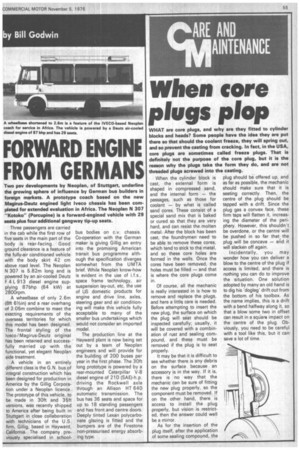When core plugs plop
Page 57

If you've noticed an error in this article please click here to report it so we can fix it.
WHAT are core plugs, and why are they fitted to cylinder blocks and heads? Some people have the idea they are put there so that should the coolant freeze, they will spring out, and so prevent the casting from cracking. In fact, in the USA, core plugs are sometimes called freeze plugs. That is definitely not the purpose of the core plug, but it is the reason why the plugs take the form they do, and are not threaded plugs screwed into the casting.
When the cylinder block is cast, the external form is shaped in compressed sand, and the internal form — the passages, such as those for coolant — by what is called sand cores. These consist of a special sand mix that is baked or cured SO that they are very hard, and can resist the molten metal. After the block has been cast, the foundrymen need to be able to remove these cores, which tend to stick to the metal, and so these core holes are formed in the walls. Once the cores have been removed, the holes must be filled — and that is where the core plugs come in.
Of course, all the mechanic is really interested in is how to remove and replace the plugs, and here a little care is needed. Before attempting to insert the new plug, the surface on which the plug will seat should be inspected carefully; usually, it will be covered with a combination of rust and sealing compound, and these must be removed if the plug is to seat properly.
It may be that it is difficult to see whether there is any debris on the surface because an accessory is in the way. If it is, there is no way that the mechanic can be sure of fitting the new plug properly, so the component must be removed. If on the other hand, there is access to install the plug properly, but vision is restricted, then the answer could well be a mirror.
As for the insertion of the plug itself, after the application of some sealing compound, the plug should be offered up, and as far as possible, the mechanic should make sure that it is seating correctly. Then, the centre of the plug should be, tapped with a drift. Since the plug gas a convex face, these firm taps will flatten it, increasing the diameter of the periphery. However, this shouldn't be overdone, or the centre will be pushed in so far that the plug will be concave — and it will slacken off again.
Incidentally, you may wonder how you can deliver a blow to the centre of the plug if access is limited, and there is nothing you can do to improve the situation. One solution adopted by many an old hand is to dig his 'dogleg' drift out from the bottom of his toolbox. As the name implies, this is a drift with a bend halfway along it, so that a blow some two in offset can result in a square impact on the centre of the plug. Obviously, you need to be careful with a tool like this, but it can save a lot of time.
































































































